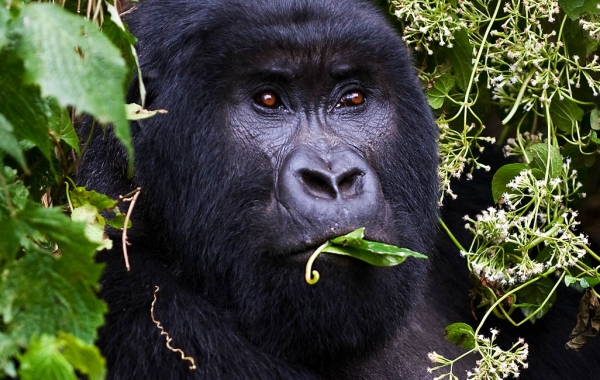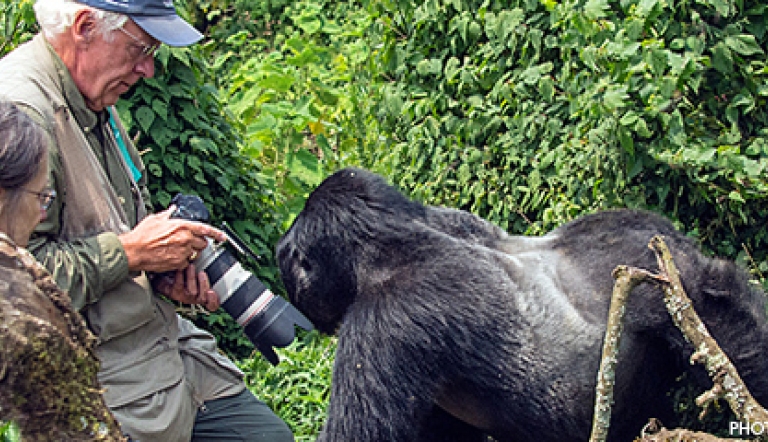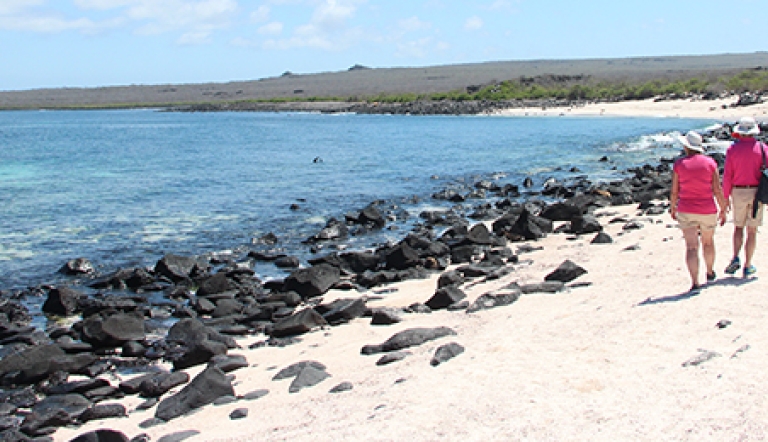The country’s abundance of flora and fauna attracts tourists by the thousands each year and makes for an extraordinary trip.
Uganda is situated on a plateau with snow-capped mountains reaching elevations over 16,000 feet in the Ruwenzori Range, which is located in the northern region of the country. After visiting mountains in the sky, step into the Bwindi National Park to reconnect with nature while enjoying wildlife observation. The park is located in southwestern Uganda and home to hundreds of mountain gorillas and over 350 species of birds. Stay at one of the lodges in the Bwindi Impenetrable Forest for a guided tour. The two locations, Buhoma in the north and Nkuringo in the south, both offer different experiences.
Benefiting from a rich history, Uganda has also maintained a variety of unique cultures. Native tribes have their own indigenous music. In the north, the Acholi and Langi tribes are heard playing a thumb piano, while the western tribes of the Banyankore perform a graceful style of percussion music. A medley of song and dance can be witnessed throughout the country.
Holbrook has years of experience planning explorations throughout Africa. Using our expertise, we look forward to crafting an unforgettable trip for you.
Entry & Exit Requirements
U.S. citizens must have a valid passport to enter Uganda. Passports must be valid for at least six months beyond the date of entry and have at least two full blank pages available for the entry/visa stamps.
A tourist visa is also required for entry. Visas are not available at the airport upon arrival; travelers must apply for a visa online at least two weeks prior to travel by completing the e-visa application form and making payment online at https://visas.immigration.go.ug. (The earliest you can apply is 3 months prior to arrival.)
To apply, you will need your passport, a recent passport-size photo, and a yellow fever certificate (see below for more information). The fee for a single-entry visa is USD $55 (subject to change), payable by Visa or MasterCard.
Please be aware that the online system will ask you to input your requested duration of stay. Be aware the count begins not from your date of entry, but from the date of visa approval. For this reason, we recommend applying for a 3-month visa, the maximum allowed, as this gives you 90 days from the date of visa approval to enter the country. (Please verify that this timeframe corresponds with your travel plans. If you do not enter the country within the specified number of days, you will forfeit your visa and any fees paid and must apply again.)
Once payment is made, the system will process your application and send you a barcoded email. Print out this email and bring it with you to Uganda. Upon arrival you should present the barcoded email to the immigration officer, who will scan the barcode, take your fingerprints and photo, and place a visa in your passport.
If you are not traveling with a U.S. passport, please check with the Ugandan Embassy for the requirements based on your nationality.
Health Information
IMMUNIZATIONS
The Centers for Disease Control recommends that all travelers be up to date on routine vaccinations such as measles-mumps-rubella (MMR) vaccine, diphtheria-pertussis-tetanus vaccine, varicella (chicken pox) vaccine, and your yearly flu shot before every trip.
Proof of vaccination against yellow fever is required for all travelers (age 1 year or older) entering Uganda. Please note: Yellow fever vaccine availability is currently limited in the US. To receive the vaccine, you may need to travel some distance and schedule your appointment well in advance. You will need to show your yellow fever certificate to apply for your visa, and your visa application must be submitted at least two weeks before departure; for this reason, we strongly recommend making arrangements for your yellow fever vaccine well in advance of your departure.
Though not required, the CDC recommends hepatitis A, hepatitis B, and typhoid vaccines for most unvaccinated travelers visiting Uganda. The CDC also recommends the polio vaccine for unvaccinated travelers, or a single lifetime booster dose of Inactivated Polio Vaccine (IPV) for adults who previously completed the full, routine polio vaccine series as children.
Additional vaccines may be recommended for some travelers. Please consult your physician for additional information and recommendations based on your individual circumstances.
MALARIA
The CDC warns that travelers to Uganda may be at risk for exposure to malaria. Malaria is caused by a parasite found in Anopheles mosquitos, which are active from dusk until dawn. Prevention is twofold: the use of anti-malarial drugs and the prevention of mosquito bites. To protect against mosquito bites, cover exposed skin with lightweight, long-sleeved shirts and pants, consider treating clothes with permethrin, and use an insect repellent containing an active ingredient like DEET or picaridin. Apply sunscreen first, followed by the repellent (preferably 20 minutes later).If you choose to use an anti-malarial drug, as recommended by the CDC, see your physician for a prescription.
OTHER VECTOR-BORNE ILLNESSES
Other vector-borne illnesses are known to occur in Uganda, including dengue fever, chikungunya, Zika virus, African tick-bite fever, and others. Travelers should protect themselves against insect and tick bites using the measures described above.
After spending time outdoors in grassy or wooded areas, the CDC recommends showering and conducting a full-body check for ticks. If you find a tick attached to your skin, safely remove it as soon as possible.
As a precaution, the CDC advises women who are pregnant to consider postponing travel to any area where Zika virus transmission is ongoing.
WILDLIFE
Follow all instructions from your guides regarding wildlife. Animals may become aggressive to protect themselves, their young or their mates, or to guard a food supply. Do not make sudden movements either toward or away from them, as this may be interpreted as threatening or territorial. Avoid stray dogs, as they may carry rabies. In the unlikely event of being bitten or scratched by a dog or other mammal, clean the wound and control bleeding. Seek medical attention immediately.
SUN EXPOSURE
The effects of the sun can be damaging to the eyes and skin. Spending time outdoors exposes you to the sun’s harmful ultraviolet (UV) rays, even on cloudy days. To protect yourself from the sun, use a broad spectrum sunscreen of at least SPF 15, protect skin with clothing, wear a wide-brimmed hat and sunglasses, and drink plenty of fluids.
Suggested Packing List
Everyone has personal preferences when it comes to packing; for this reason, the information below is offered as a general guide and not a definitive list. You know yourself best: Use your discretion and pack what you think will serve you, based on your personal preferences and specific itinerary.
You may find many of the items below in our Gear Store.
CLOTHING
Bring enough clothing suitable for the length of your program. If you prefer to pack light, note that many hotels offer laundry services at additional cost. If you plan to hand-wash items, remember that humidity may delay drying time.
Pack clothing that can be worn in layers to adapt to weather changes throughout the day. Clothing that wicks away moisture and dries quickly is recommended. Casual, safari-style clothing is suitable for most activities. Uganda's rainy season is September to November and March to May.
Bring clothes in neutral or muted colors such as green, khaki, brown, or gray. We recommend that you avoid wearing bright colors or white as they can easily be spotted by animals. In addition, blue is particularly attractive to certain insects and should be avoided. It is illegal for civilians to wear army-style camouflage clothing in Uganda.
- A combination of short-sleeved and lightweight, long-sleeved shirts for sun and mosquito protection
- Shorts or skirts (knee-length or longer)
- Lightweight, quick-drying long pants for sun and mosquito protection
- Undergarments
- Sleepwear
- Lightweight jacket or sweater/sweatshirt (or heavier weight if visiting high-elevation areas)
- Bathing suit(s)
- Socks – Bring extra pairs
- Shoes – Consider your specific itinerary when choosing footwear. For most programs, you’ll likely want at least one pair of comfortable, closed-toe walking or hiking shoes suitable for forest hikes and walking over cobblestones or other uneven terrain. Sturdy hiking boots are recommended for gorilla forest hikes. In addition, many participants opt for a pair of sturdy sport-strap sandals (e.g. Keens, Tevas, or similar) and/or casual flip-flops or sandals for around your hotel room.
- Lightweight rain jacket, hooded poncho, and/or windbreaker
- Visor or wide-brimmed sun hat with ties
- Bandana, scarf, or Buff-style headwear
- Leather, gardening-type gloves (for gorilla treks)
Personal Toiletries
Pack toiletries based on your personal preferences and habits. Below are just a few recommendations to keep in mind.
- Shampoo, conditioner, lotion, deodorant/antiperspirant , etc. – If possible, avoid strong fragrances.
- Soap and washcloth or a small, quick-drying microfiber towel – Washcloths are not standard in all hotels. If you normally use a washcloth, you may wish to bring one from home.
- Hairbrush, comb, hair ties, shower cap. Most—but not all—hotel rooms provide a hair dryer, but you may wish to bring one from home.
- Toothbrush and toothpaste
- Razor
- Ear plugs, especially if you are a light sleeper
- Feminine hygiene products
- Insect repellent with DEET or picaridin (see note below about treating clothing with permethrin)
- Sunscreen and lip balm with SPF
- Aloe vera gel
- A travel pack of tissues – also useful as napkins or toilet paper if needed
In addition to your personal toiletries, it is useful to pack a small medical kit, which you can easily prepare. Helpful items might include: bandages, antihistamine, a pain reliever, motion sickness and/or altitude sickness medication (if you are prone to either), anti-diarrhea medicine, individually wrapped pre-moistened towelettes and/or hand sanitizer, antibiotic ointment, anti-fungal cream, moleskin for blisters, eye drops, tweezers, a mini sewing kit, and an extra pair of disposable contact lenses or eyeglasses if you wear them.
Days before you leave home, you may wish to consider spraying any clothing, socks, and shoes that will be worn in lowland, tropical sites with permethrin, an anti-parasite medication, to repel irritating pests and prevent the spread of disease. A recommended brand is Sawyer. Carefully read all instructions before use. Please note permethrin is highly toxic to cats and fish, and some aerosol products may be harmful to birds. Side effects may include minor itching, burning, or redness. You may want to use a laundry marker to label and keep track of which socks are permethrinized. Only one application per item is necessary; permethrin on treated clothes remains effective through several washings. Permethrin should NOT be applied directly to skin.
Miscellaneous
Remember to pack valuables such as your passport, cash/credit cards, and medications in your carry-on luggage.
- Passport, visa, and photocopies of all travel documentation
- Yellow fever certificate
- Personal insurance card and travel insurance information
- Money – ATM/credit card, traveler's checks, and/or cash; small bills in good condition are recommended
- Prescription medicines (if applicable), with a copy of the prescription
- Sunglasses with strap
- Small day pack for hikes and excursions
- Flashlight and/or head lamp
- Travel alarm clock or inexpensive waterproof wristwatch with alarm – Not all hotels provide alarm clocks.
- A pocket calculator or phone to assist with conversions and currency exchange
- Binoculars with lens cleaner
- Camera and related equipment, such as charger, lenses, and extra memory cards
- Reusable water bottle
- Non-perishable snacks
- Pocket-knife or multipurpose tool - Pack in your checked luggage
- Reusable zip-top style bags – useful for packing toiletries, sorting clothing, storing damp or muddy shoes, or as a dry bag for protecting electronics
- Notepad or travel journal and pen
- Music or reading material for down time, long bus drives, or on the airplane, and a portable bright light to read by
- Collapsible walking stick with rubber tip
- A small quantity of laundry detergent if you’ll be washing clothing by hand
- Travel-size umbrella – Some people find this unwieldy to carry, while others find it offers better protection than a rain jacket alone.
- Money belt
- Chargers for electronics
- Converter and adapter
Plastic bags
Due to Uganda's ban on plastic bags, travelers are not permitted to bring plastic bags into the country. This includes garbage bags and grocery/shopping bags. Zip-top style bags specifically used to carry toiletries per TSA’s liquids rule are still permitted on the assumption that they will be reused on the return flight. Items purchased at the airport before boarding the aircraft should be removed from plastic bags. Please double-check your carry-on luggage before disembarking in Uganda; any plastic bags should be left on the plane to avoid delays and possibly fines.
LUGGAGE WEIGHT RESTRICTIONS
Pack lightly. Charter flights have a baggage weight limit of a maximum of 30 lbs. If your bags are heavier, it is likely you will be required to pay an excess luggage fee. For this reason, soft bags are preferable to hard suitcases.































